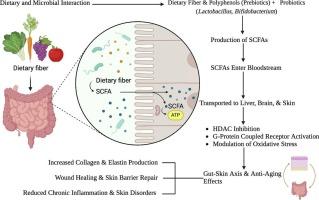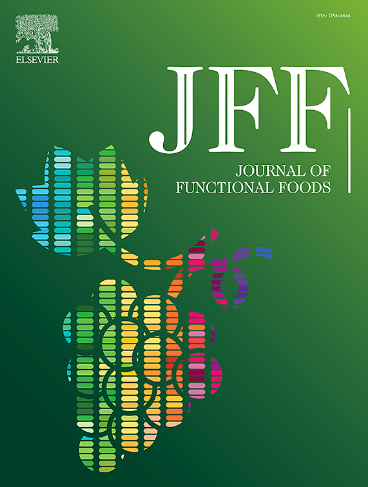A review of short-Chain fatty acids in gut and skin: Possible implications in skin aging
IF 4
2区 农林科学
Q2 FOOD SCIENCE & TECHNOLOGY
引用次数: 0
Abstract
The gut–skin axis is an active and bidirectional communication in which gut microbiota impacts skin health and disease. One of the most common microbial metabolites is short-chain fatty acids (SCFAs), which are composed of acetate, propionate, and butyrate generated from the fermentation of dietary fibers. SCFAs are bioactive in nature that are essential in regulating inflammation, immune signalling, oxidative stress, and skin barrier function. In addition, SCFAs stimulate the differentiation of keratinocytes, acetylation of collagen, and have antimicrobial properties, which are important in establishing skin homeostasis and longevity. Currently, new approaches are underway to develop dietary patterns, probiotic strategies, functional food, and delivery systems to induce SCFA generation and function in vivo. Relevant research and review articles were collected using databases such as PubMed, Google Scholar, and Scopus for the information required for this comprehensive review. Key terms used for literature search included gut-skin axis, SCFA, functional food, epithelial integrity, skin aging, inflammation, etc. In this review, we tried to summarised the role and mechanisms of SCFA in gut-skin aging from the published research evidence and discussed on the role of functional foods in managing aging-related diseases.

肠道和皮肤中短链脂肪酸的研究进展:可能与皮肤老化有关
肠道-皮肤轴是一个活跃的双向交流,肠道微生物群影响皮肤健康和疾病。短链脂肪酸是最常见的微生物代谢物之一,由膳食纤维发酵产生的醋酸盐、丙酸盐和丁酸盐组成。SCFAs在自然界中具有生物活性,在调节炎症、免疫信号、氧化应激和皮肤屏障功能方面是必不可少的。此外,SCFAs刺激角质形成细胞的分化,胶原的乙酰化,并具有抗菌特性,这对建立皮肤稳态和长寿很重要。目前,人们正在开发新的方法来开发饮食模式、益生菌策略、功能食品和递送系统,以诱导体内SCFA的产生和功能。使用PubMed、b谷歌Scholar和Scopus等数据库收集相关研究和综述文章,以获取本综合综述所需的信息。文献检索的关键词包括肠-皮轴、SCFA、功能性食品、上皮完整性、皮肤老化、炎症等。在这篇综述中,我们试图从已发表的研究证据中总结SCFA在肠道皮肤衰老中的作用和机制,并讨论功能食品在治疗衰老相关疾病中的作用。
本文章由计算机程序翻译,如有差异,请以英文原文为准。
求助全文
约1分钟内获得全文
求助全文
来源期刊

Journal of Functional Foods
FOOD SCIENCE & TECHNOLOGY-
CiteScore
9.60
自引率
1.80%
发文量
428
审稿时长
76 days
期刊介绍:
Journal of Functional Foods continues with the same aims and scope, editorial team, submission system and rigorous peer review. We give authors the possibility to publish their top-quality papers in a well-established leading journal in the food and nutrition fields. The Journal will keep its rigorous criteria to screen high impact research addressing relevant scientific topics and performed by sound methodologies.
The Journal of Functional Foods aims to bring together the results of fundamental and applied research into healthy foods and biologically active food ingredients.
The Journal is centered in the specific area at the boundaries among food technology, nutrition and health welcoming papers having a good interdisciplinary approach. The Journal will cover the fields of plant bioactives; dietary fibre, probiotics; functional lipids; bioactive peptides; vitamins, minerals and botanicals and other dietary supplements. Nutritional and technological aspects related to the development of functional foods and beverages are of core interest to the journal. Experimental works dealing with food digestion, bioavailability of food bioactives and on the mechanisms by which foods and their components are able to modulate physiological parameters connected with disease prevention are of particular interest as well as those dealing with personalized nutrition and nutritional needs in pathological subjects.
 求助内容:
求助内容: 应助结果提醒方式:
应助结果提醒方式:


